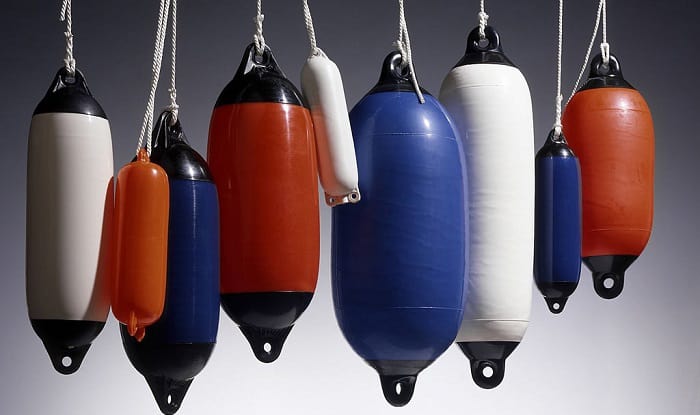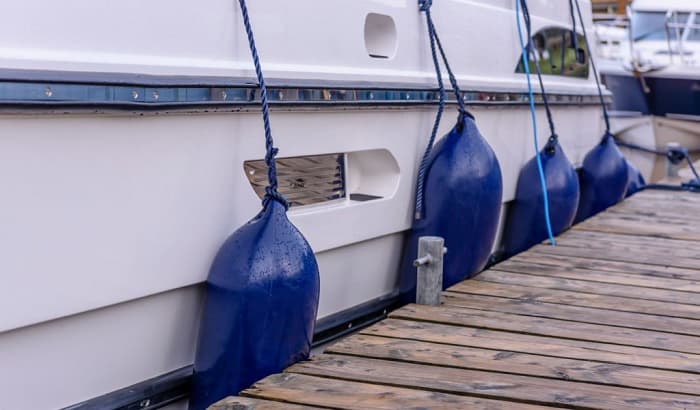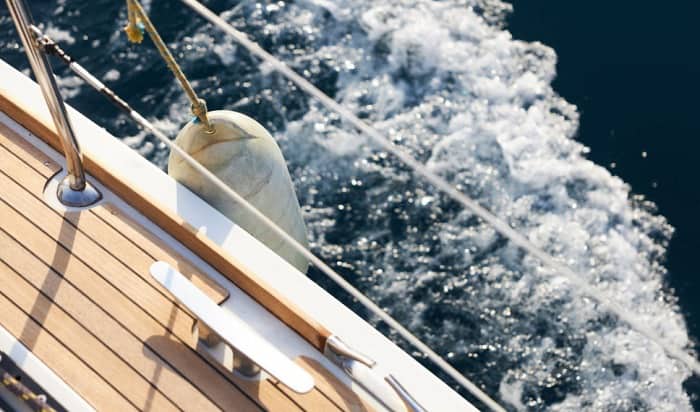Boat fenders come in the form of an inflatable or padded cushion. They are responsible for preventing your boat from bumping into another vessel, dock, or other things on the water.
As a rule of thumb, a fender that has one-inch thickness should be allocated for every four or five feet of your craft’s length. Small vessels generally need only two while those over 40 feet may need six pieces.
What size boat fenders do I need? You may have this question in mind before buying fenders. By all means, you would want the right protective gear for your boat. You won’t be disappointed with your purchase once you read everything here.
Table of Contents
Different Kinds of Fenders
The kinds of fenders are certainly linked to the size, so be familiar with them first. Some are hung vertically while others are positioned horizontally.
Cylindrical
You’ll notice that there are two “eyes” on both sides of this fender. These are for you to hang vertically. There’s a bowline knot that is tied on one of the eyes for security.
You should know that a cylindrical fender can also be laid out horizontally with a stopper that looks like number eight in both eyes.
Round
This one is made of soft vinyl and you will likely see it on large boats with flared or concave bows.
Center Rope Cylindrical
You’re free to install it horizontally or vertically because it has a hole in the middle where a rope is.
Flat
It’s also called a foam buffer and is used for small boats. You have to place it on the gunwale for protection from collisions.
Transom Mounted
This is a Mediterranean style fender used for docking. It shields the swim step and transoms from damage.
Low Freeboard
It sits high on the hull while hanging inward on the gunwale. The smaller size of this fender is typically to cater to fishing, ski, and bass boats. You’ll see it sitting low in the water. The bigger ones are attached to bigger crafts to protect them when encountering waves. There’s no chance of riding up or riding below high docks.
Rafting Cushion
It is used to raft boats together and it makes piling possible through its two rows of center holes. A couple of these can handle a wide surface area with six molded tubes.
It’s versatile due to mounting options as adding several of them won’t result in rolling or riding up.
Tuff End
It has a rugged and heavy-duty construction with a large diameter. This type of fender provides the needed protection of vessels that have deep V hulls. It’s best for huge crafts and commercial applications.
V-shaped Freedom
What’s cool about this fender is that it can stay in place despite the boat’s movements. Moreover, it’s suitable for small boats and yachts.
For Pontoons
Some of the great fenders for pontoons are Pontoon Curve Protector, Pontoon Protector 90, Fence Saver II, and Taylor Made 31035.
Ways to Make Sure that You Get the Right Fenders
Here are some things that you should consider to guarantee that you have the right fenders.
- The main step that you have to take to acquire the most suitable fenders is checking your boat size. You will see in the guide below what matches your vessel.
- It won’t be much of a problem if you have some fenders that you use at the moment. There’s no need to switch if they work well. However, it’s still recommended to take references from the guide.
- The environment of the area where you usually dock has a role to play too. Small-sized ones can serve well in a calm marina while large fenders should be the option for choppy waters.
Here is a fender size guide for your reference.
Fender Size Guide
| Boat Length | Cylindrical | Round | Flat |
| Below 10ft | 3 inches | Not required | Small |
| 10 – 15ft | 3 – 4 inches | 9 inches | Small |
| 15 – 20ft | 5 – 5.5 inches | 12 inches | Small |
| 20 – 25ft | 6 – 6.5 inches | 15 inches | Medium |
| 25 – 35ft | 8 – 8.5 inches | 18 inches | Medium |
| 35 – 50ft | 10.5 – 12 inches | 21 inches | Large |
| 50 – 60ft | 12 inches | 27 inches | Large |
| 60 – 72ft | 15 – 24 inches | 27 inches | Large |
Heavy-duty range suits larger, commercial water vessels. This guide is crystal clear so you can easily find the fenders that are perfect for your boat.
More about Identifying the Suitable Boat Fenders
Ball Fenders
These fenders are tough enough to resist crushing impact as long as they’re properly inflated. They are great for boats with several bow flares because they have a width that can keep the lower deck from smashing onto the dock.
Also, they are recommended for vessels with large storage capacities as they occupy a lot of space when inflated. If it suits your boat, you have to take note that for every 4 to 5 feet of the boat’s length, 2 inches of diameter are needed.
Therefore, a 21-inch diameter is applicable for a craft that is 30 to 35 feet long. When it comes to those that are 50 feet long and up, a 27-inch diameter is needed.
Mission Sentry Fenders
It’s a product of innovation specifically for tow-sports boats. Nonetheless, it can also be used for smaller vessels. This kind of fender is made of closed-cell foam designed to protect the upper and lower parts of the rub rail.
The built-in adjustable strap can put these fenders in place even though they hang off the dock or cleats. Placing them below the rail creates an inward angle that can protect the boat under the waterline.
You’ll find it easy to stow aboard small vessels because these are slim and don’t need additional lines.
Cylindrical Fenders
These are considered the traditional type of fenders so they’re available in various shapes and sizes. With many sizes, you won’t be caught up to find the right ones for your boat once you know the rule in sizing.
As stated in the guide above, an inch diameter of this fender matches every 4 to 5 feet of a boat’s length. Thus, 6-inch fenders should be used for 20 to 25 feet boats while 8-inch ones are right for 25 to 35 feet boats.
The bigger the diameter, the more protection your boat can receive from these fenders. So, it’s not a problem if you get the biggest cylindrical fenders for the security of the hull and dock.
These fenders can be arranged vertically or horizontally. Hanging it horizontally is perfect for boat sections that might rub against pilings. They’re the ones that can help you with pulling side-to at the pier or dock.
Conclusion
With many fender styles and sizes, this article has shown you the answers to the question ‘What size boat fenders do I need?’. It’s important to get the right one to ensure that you protect your boat when it’s underway or being docked.
If you don’t have the right fenders, you can’t expect to get the protection that you may need in some circumstances. That’s the whole point of its importance!

I am passionate about water sports and technical fields, so combining both makes me interested in making contents about boat accessories. With my partner, we went on many trips and sports games together, which led us to think about how we can spread our joys and passions to many people.



